
PAL (Program-Aided Language Models)
Theo: https://www.promptingguide.ai/techniques/pal
Gao và cộng sự (2022) trình bày một phương pháp sử dụng LLM để đọc các bài toán ngôn ngữ tự nhiên và tạo ra các chương trình như các bước suy luận trung gian. Được đặt tên là mô hình ngôn ngữ hỗ trợ chương trình - PAL (Program-Aided Language Model), phương pháp này khác với phương pháp lời nhắc chuỗi tư duy (CoT) ở chỗ thay vì sử dụng văn bản dạng tự do để tìm ra lời giải, nó chuyển giao bước giải cho một chương trình thực thi như trình thông dịch Python.
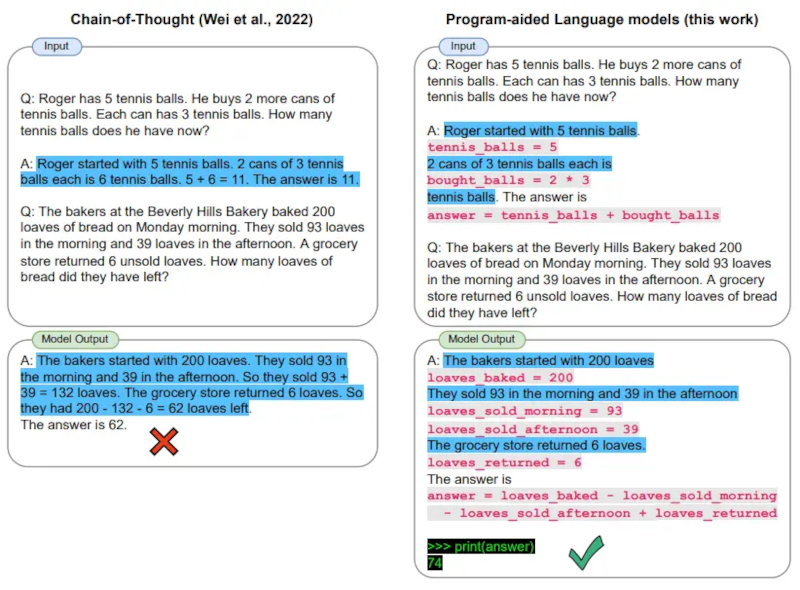
Image Source: Gao et al., (2022)
Hãy xem xét một ví dụ sử dụng LangChain và OpenAI GPT-3. Chúng tôi quan tâm đến việc phát triển một ứng dụng đơn giản có khả năng diễn giải câu hỏi được hỏi và đưa ra câu trả lời bằng cách tận dụng trình thông dịch Python.
Cụ thể, chúng tôi quan tâm đến việc tạo ra một chức năng cho phép sử dụng LLM để trả lời các câu hỏi yêu cầu hiểu biết về dữ liệu. Chúng tôi sẽ cung cấp cho LLM một lời nhắc bao gồm một vài ví dụ được áp dụng từ đây.
Đây là những nội dung chúng tôi cần:
import openai
from datetime import datetime
from dateutil.relativedelta import relativedelta
import os
from langchain.llms import OpenAI
from dotenv import load_dotenv
Trước tiên chúng ta hãy cấu hình một vài thứ:
load_dotenv()
# API configuration
openai.api_key = os.getenv("OPENAI_API_KEY")
# for LangChain
os.environ["OPENAI_API_KEY"] = os.getenv("OPENAI_API_KEY")
Thiết lập phiên bản mô hình:
llm = OpenAI(model_name='text-davinci-003', temperature=0)
Thiết lập lời nhắc + câu hỏi:
câu hỏi = "Hôm nay là ngày 27 tháng 2 năm 2023. Tôi sinh ra cách đây đúng 25 năm. Vậy ngày sinh của tôi là bao nhiêu theo MM/DD/YYYY?"
DATE_UNDERSTANDING_PROMPT = """
# Hỏi: 36 giờ nữa là năm 2015. Vậy một tuần nữa tính từ hôm nay theo định dạng MM/DD/YYYY là ngày nào?
# Nếu 36 giờ nữa là năm 2015, thì hôm nay là 36 giờ trước đó.
today = datetime(2015, 1, 1) - relativedelta(hours=36)
# Một tuần nữa tính từ hôm nay,
one_week_from_today = today + relativedelta(weeks=1)
# Câu trả lời được định dạng bằng %m/%d/%Y là
one_week_from_today.strftime('%m/%d/%Y')
# Hỏi: Ngày đầu tiên của năm 2019 là Thứ Ba, và hôm nay là Thứ Hai đầu tiên của năm 2019. Vậy hôm nay là ngày nào theo định dạng MM/DD/YYYY?
# Nếu ngày đầu tiên của năm 2019 là Thứ Ba, và hôm nay là Thứ Hai đầu tiên của 2019, thì hôm nay là 6 ngày sau.
today = datetime(2019, 1, 1) + relativedelta(days=6)
# Câu trả lời được định dạng bằng %m/%d/%Y là today.strftime('%m/%d/%Y')
# Hỏi: Buổi hòa nhạc dự kiến diễn ra vào ngày 06/01/1943, nhưng bị hoãn lại một ngày so với hôm nay. 10 ngày trước là ngày nào theo định dạng MM/DD/YYYY?
# Nếu buổi hòa nhạc dự kiến diễn ra vào ngày 06/01/1943, nhưng bị hoãn lại một ngày so với hôm nay, thì hôm nay là một ngày sau.
today = datetime(1943, 6, 1) + relativedelta(days=1)
# 10 ngày trước,
ten_days_ago = today - relativedelta(days=10)
# Câu trả lời được định dạng bằng %m/%d/%Y là ten_days_ago.strftime('%m/%d/%Y')
# Hỏi: Hôm nay là ngày 19/4/1969. Vậy 24 giờ sau đó tính theo MM/DD/YYYY là ngày nào?
# Hôm nay là ngày 19/4/1969.
today = datetime(1969, 4, 19)
# 24 giờ sau,
later = today + relativedelta(hours=24)
# Câu trả lời được định dạng theo %m/%d/%Y là today.strftime('%m/%d/%Y')
# Hỏi: Jane nghĩ hôm nay là ngày 11/3/2002, nhưng thực tế hôm nay là ngày 12/3, tức là muộn hơn 1 ngày. Vậy 24 giờ sau đó tính theo MM/DD/YYYY là ngày nào?
# Nếu Jane nghĩ hôm nay là ngày 11/3/2002, nhưng thực tế hôm nay là ngày 12/3, thì hôm nay là 3/12/2002.
today = datetime(2002, 3, 12)
# 24 giờ sau,
later = today + relativedelta(hours=24)
# Câu trả lời được định dạng theo %m/%d/%Y là later.strftime('%m/%d/%Y')
# Hỏi: Jane sinh vào ngày cuối cùng của tháng 2 năm 2001. Hôm nay là sinh nhật 16 tuổi của cô ấy. Vậy ngày hôm qua là ngày nào theo định dạng MM/DD/YYYY?
# Nếu Jane sinh vào ngày cuối cùng của tháng 2 năm 2001 và hôm nay là sinh nhật 16 tuổi của cô ấy, thì hôm nay là 16 năm sau.
today = datetime(2001, 2, 28) + relativedelta(years=16)
# Hôm qua,
yesterday = today - relativedelta(days=1)
# Câu trả lời được định dạng theo %m/%d/%Y là ngày hôm qua.strftime('%m/%d/%Y')
# Q: {câu hỏi}
""".strip() + '\n'
llm_out = llm(DATE_UNDERSTANDING_PROMPT.format(question=question))
print(llm_out)
Điều này sẽ đưa ra kết quả sau:
# Nếu hôm nay là ngày 27 tháng 2 năm 2023 và tôi sinh ra đúng 25 năm trước, thì tôi đã sinh ra 25 năm trước đó.
today = datetime(2023, 2, 27)
# Tôi sinh ra 25 năm trước,
born = today - relativedelta(years=25)
# Câu trả lời được định dạng bằng %m/%d/%Y là born.strftime('%m/%d/%Y')
Nội dung của llm_out là một đoạn mã Python. Dưới đây, lệnh exec được sử dụng để thực thi đoạn mã Python này.
exec(llm_out)
print(born)
Điều này sẽ đưa ra kết quả sau: 27/02/1998
Về ‘Kỹ thuật viết lời nhắc’ ………. Phần trước ………. Phần tiếp theo
Gao et al., (2022) presents a method that uses LLMs to read natural language problems and generate programs as the intermediate reasoning steps. Coined, program-aided language models (PAL), it differs from chain-of-thought prompting in that instead of using free-form text to obtain solution it offloads the solution step to a programmatic runtime such as a Python interpreter.
Image Source: Gao et al., (2022)
Let's look at an example using LangChain and OpenAI GPT-3. We are interested to develop a simple application that's able to interpret the question being asked and provide an answer by leveraging the Python interpreter.
Specifically, we are interested to create a functionality that allows the use of the LLM to answer questions that require date understanding. We will provide the LLM a prompt that includes a few exemplars which are adopted from here.
These are the imports we need:
import openaifrom datetime import datetimefrom dateutil.relativedelta import relativedeltaimport osfrom langchain.llms import OpenAIfrom dotenv import load_dotenv
Let's first configure a few things:
load_dotenv()# API configurationopenai.api_key = os.getenv("OPENAI_API_KEY")# for LangChainos.environ["OPENAI_API_KEY"] = os.getenv("OPENAI_API_KEY")
Setup model instance:
llm = OpenAI(model_name='text-davinci-003', temperature=0)
Setup prompt + question:
question = "Today is 27 February 2023. I was born exactly 25 years ago. What is the date I was born in MM/DD/YYYY?"DATE_UNDERSTANDING_PROMPT = """# Q: 2015 is coming in 36 hours. What is the date one week from today in MM/DD/YYYY?# If 2015 is coming in 36 hours, then today is 36 hours before.today = datetime(2015, 1, 1) - relativedelta(hours=36)# One week from today,one_week_from_today = today + relativedelta(weeks=1)# The answer formatted with %m/%d/%Y isone_week_from_today.strftime('%m/%d/%Y')# Q: The first day of 2019 is a Tuesday, and today is the first Monday of 2019. What is the date today in MM/DD/YYYY?# If the first day of 2019 is a Tuesday, and today is the first Monday of 2019, then today is 6 days later.today = datetime(2019, 1, 1) + relativedelta(days=6)# The answer formatted with %m/%d/%Y istoday.strftime('%m/%d/%Y')# Q: The concert was scheduled to be on 06/01/1943, but was delayed by one day to today. What is the date 10 days ago in MM/DD/YYYY?# If the concert was scheduled to be on 06/01/1943, but was delayed by one day to today, then today is one day later.today = datetime(1943, 6, 1) + relativedelta(days=1)# 10 days ago,ten_days_ago = today - relativedelta(days=10)# The answer formatted with %m/%d/%Y isten_days_ago.strftime('%m/%d/%Y')# Q: It is 4/19/1969 today. What is the date 24 hours later in MM/DD/YYYY?# It is 4/19/1969 today.today = datetime(1969, 4, 19)# 24 hours later,later = today + relativedelta(hours=24)# The answer formatted with %m/%d/%Y istoday.strftime('%m/%d/%Y')# Q: Jane thought today is 3/11/2002, but today is in fact Mar 12, which is 1 day later. What is the date 24 hours later in MM/DD/YYYY?# If Jane thought today is 3/11/2002, but today is in fact Mar 12, then today is 3/12/2002.today = datetime(2002, 3, 12)# 24 hours later,later = today + relativedelta(hours=24)# The answer formatted with %m/%d/%Y islater.strftime('%m/%d/%Y')# Q: Jane was born on the last day of Feburary in 2001. Today is her 16-year-old birthday. What is the date yesterday in MM/DD/YYYY?# If Jane was born on the last day of Feburary in 2001 and today is her 16-year-old birthday, then today is 16 years later.today = datetime(2001, 2, 28) + relativedelta(years=16)# Yesterday,yesterday = today - relativedelta(days=1)# The answer formatted with %m/%d/%Y isyesterday.strftime('%m/%d/%Y')# Q: {question}""".strip() + '\n'llm_out = llm(DATE_UNDERSTANDING_PROMPT.format(question=question))print(llm_out)
Gao et al., (2022) presents a method that uses LLMs to read natural language problems and generate programs as the intermediate reasoning steps. Coined, program-aided language models (PAL), it differs from chain-of-thought prompting in that instead of using free-form text to obtain solution it offloads the solution step to a programmatic runtime such as a Python interpreter.
Let's look at an example using LangChain and OpenAI GPT-3. We are interested to develop a simple application that's able to interpret the question being asked and provide an answer by leveraging the Python interpreter.
Specifically, we are interested to create a functionality that allows the use of the LLM to answer questions that require date understanding. We will provide the LLM a prompt that includes a few exemplars which are adopted from here.
These are the imports we need:
import openaifrom datetime import datetimefrom dateutil.relativedelta import relativedeltaimport osfrom langchain.llms import OpenAIfrom dotenv import load_dotenv
Let's first configure a few things:
load_dotenv()# API configurationopenai.api_key = os.getenv("OPENAI_API_KEY")# for LangChainos.environ["OPENAI_API_KEY"] = os.getenv("OPENAI_API_KEY")
Setup model instance:
llm = OpenAI(model_name='text-davinci-003', temperature=0)
Setup prompt + question:
question = "Today is 27 February 2023. I was born exactly 25 years ago. What is the date I was born in MM/DD/YYYY?"DATE_UNDERSTANDING_PROMPT = """# Q: 2015 is coming in 36 hours. What is the date one week from today in MM/DD/YYYY?# If 2015 is coming in 36 hours, then today is 36 hours before.today = datetime(2015, 1, 1) - relativedelta(hours=36)# One week from today,one_week_from_today = today + relativedelta(weeks=1)# The answer formatted with %m/%d/%Y isone_week_from_today.strftime('%m/%d/%Y')# Q: The first day of 2019 is a Tuesday, and today is the first Monday of 2019. What is the date today in MM/DD/YYYY?# If the first day of 2019 is a Tuesday, and today is the first Monday of 2019, then today is 6 days later.today = datetime(2019, 1, 1) + relativedelta(days=6)# The answer formatted with %m/%d/%Y istoday.strftime('%m/%d/%Y')# Q: The concert was scheduled to be on 06/01/1943, but was delayed by one day to today. What is the date 10 days ago in MM/DD/YYYY?# If the concert was scheduled to be on 06/01/1943, but was delayed by one day to today, then today is one day later.today = datetime(1943, 6, 1) + relativedelta(days=1)# 10 days ago,ten_days_ago = today - relativedelta(days=10)# The answer formatted with %m/%d/%Y isten_days_ago.strftime('%m/%d/%Y')# Q: It is 4/19/1969 today. What is the date 24 hours later in MM/DD/YYYY?# It is 4/19/1969 today.today = datetime(1969, 4, 19)# 24 hours later,later = today + relativedelta(hours=24)# The answer formatted with %m/%d/%Y istoday.strftime('%m/%d/%Y')# Q: Jane thought today is 3/11/2002, but today is in fact Mar 12, which is 1 day later. What is the date 24 hours later in MM/DD/YYYY?# If Jane thought today is 3/11/2002, but today is in fact Mar 12, then today is 3/12/2002.today = datetime(2002, 3, 12)# 24 hours later,later = today + relativedelta(hours=24)# The answer formatted with %m/%d/%Y islater.strftime('%m/%d/%Y')# Q: Jane was born on the last day of Feburary in 2001. Today is her 16-year-old birthday. What is the date yesterday in MM/DD/YYYY?# If Jane was born on the last day of Feburary in 2001 and today is her 16-year-old birthday, then today is 16 years later.today = datetime(2001, 2, 28) + relativedelta(years=16)# Yesterday,yesterday = today - relativedelta(days=1)# The answer formatted with %m/%d/%Y isyesterday.strftime('%m/%d/%Y')# Q: {question}""".strip() + '\n'llm_out = llm(DATE_UNDERSTANDING_PROMPT.format(question=question))print(llm_out)
This will output the following:
# If today is 27 February 2023 and I was born exactly 25 years ago, then I was born 25 years before.today = datetime(2023, 2, 27)# I was born 25 years before,born = today - relativedelta(years=25)# The answer formatted with %m/%d/%Y isborn.strftime('%m/%d/%Y')
The contents of llm_out are a Python code snippet. Below, the exec command is used to execute this Python code snippet.
exec(llm_out)print(born)
This will output the following: 02/27/1998
Dịch: Lê Trung Nghĩa
letrungnghia.foss@gmail.com
Tác giả: Nghĩa Lê Trung
Ý kiến bạn đọc
Những tin cũ hơn
Blog này được chuyển đổi từ http://blog.yahoo.com/letrungnghia trên Yahoo Blog sang sử dụng NukeViet sau khi Yahoo Blog đóng cửa tại Việt Nam ngày 17/01/2013.Kể từ ngày 07/02/2013, thông tin trên Blog được cập nhật tiếp tục trở lại với sự hỗ trợ kỹ thuật và đặt chỗ hosting của nhóm phát triển...
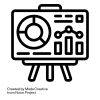 Các bài trình chiếu trong năm 2024
Các bài trình chiếu trong năm 2024
 Tập huấn thực hành ‘Khai thác tài nguyên giáo dục mở’ cho giáo viên phổ thông, bao gồm cả giáo viên tiểu học và mầm non tới hết năm 2024
Tập huấn thực hành ‘Khai thác tài nguyên giáo dục mở’ cho giáo viên phổ thông, bao gồm cả giáo viên tiểu học và mầm non tới hết năm 2024
 Các lớp tập huấn thực hành ‘Khai thác tài nguyên giáo dục mở’ tới hết năm 2024
Các lớp tập huấn thực hành ‘Khai thác tài nguyên giáo dục mở’ tới hết năm 2024
 Các tài liệu dịch sang tiếng Việt tới hết năm 2024
Các tài liệu dịch sang tiếng Việt tới hết năm 2024
 ‘Digcomp 2.2: Khung năng lực số cho công dân - với các ví dụ mới về kiến thức, kỹ năng và thái độ’, EC xuất bản năm 2022
‘Digcomp 2.2: Khung năng lực số cho công dân - với các ví dụ mới về kiến thức, kỹ năng và thái độ’, EC xuất bản năm 2022
 Tổng hợp các bài của Nhóm các Nhà cấp vốn Nghiên cứu Mở (ORFG) đã được dịch sang tiếng Việt
Tổng hợp các bài của Nhóm các Nhà cấp vốn Nghiên cứu Mở (ORFG) đã được dịch sang tiếng Việt
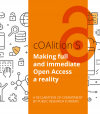 Tổng hợp các bài của Liên minh S (cOAlition S) đã được dịch sang tiếng Việt
Tổng hợp các bài của Liên minh S (cOAlition S) đã được dịch sang tiếng Việt
 Năm Khoa học Mở & Chuyển đổi sang Khoa học Mở - Tổng hợp các bài liên quan
Năm Khoa học Mở & Chuyển đổi sang Khoa học Mở - Tổng hợp các bài liên quan
 Hội nghị Đối tác Dữ liệu Mở châu Á năm 2021 do Việt Nam lần đầu tiên chủ trì
Hội nghị Đối tác Dữ liệu Mở châu Á năm 2021 do Việt Nam lần đầu tiên chủ trì
 Các khung năng lực trong hành động
Các khung năng lực trong hành động
 Phong trào Bình dân học vụ số: Mục tiêu, đối tượng, nội dung, nguồn lực, phương thức tổ chức thực hiện
Phong trào Bình dân học vụ số: Mục tiêu, đối tượng, nội dung, nguồn lực, phương thức tổ chức thực hiện
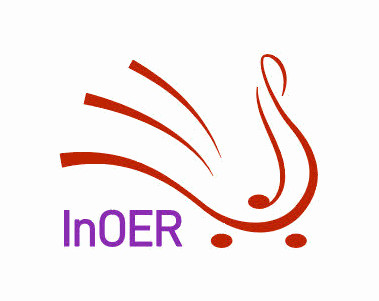 Lễ công bố công khai Trung tâm Năng lực Kim cương châu Âu và dự án ALMASI
Lễ công bố công khai Trung tâm Năng lực Kim cương châu Âu và dự án ALMASI
 Khung năng lực AI cho giáo viên
Khung năng lực AI cho giáo viên
 Ngày Phần mềm Tự do, Ngày Phần cứng tự do, Ngày Tài liệu Tự do
Ngày Phần mềm Tự do, Ngày Phần cứng tự do, Ngày Tài liệu Tự do
 ‘Khung năng lực AI cho giáo viên’ - bản dịch sang tiếng Việt
‘Khung năng lực AI cho giáo viên’ - bản dịch sang tiếng Việt
 Bạn cần biết những gì về các khung năng lực AI mới của UNESCO cho học sinh và giáo viên
Bạn cần biết những gì về các khung năng lực AI mới của UNESCO cho học sinh và giáo viên
 Bàn về 'Lợi thế của doanh nghiệp Việt là dữ liệu Việt, bài toán Việt' - bài phát biểu của Bộ trưởng Nguyễn Mạnh Hùng ngày 21/08/2025
Bàn về 'Lợi thế của doanh nghiệp Việt là dữ liệu Việt, bài toán Việt' - bài phát biểu của Bộ trưởng Nguyễn Mạnh Hùng ngày 21/08/2025
 Các tài liệu dịch sang tiếng Việt tới hết năm 2024
Các tài liệu dịch sang tiếng Việt tới hết năm 2024
 Các bài trình chiếu trong năm 2024
Các bài trình chiếu trong năm 2024
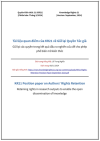 ‘Tài liệu quan điểm của KR21 về Giữ lại Quyền Tác giả: Giữ lại các quyền trong kết quả đầu ra nghiên cứu để cho phép phổ biến mở kiến thức’ - bản dịch sang tiếng Việt
‘Tài liệu quan điểm của KR21 về Giữ lại Quyền Tác giả: Giữ lại các quyền trong kết quả đầu ra nghiên cứu để cho phép phổ biến mở kiến thức’ - bản dịch sang tiếng Việt
 DeepSeek đã gây ra sự hoảng loạn trên thị trường — nhưng một số người cho rằng việc bán tháo là quá mức
DeepSeek đã gây ra sự hoảng loạn trên thị trường — nhưng một số người cho rằng việc bán tháo là quá mức
 “Chúng tôi không có hào nước”: Sự đổi mới đột phá của AI nguồn mở
“Chúng tôi không có hào nước”: Sự đổi mới đột phá của AI nguồn mở
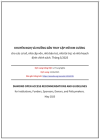 ‘KHUYẾN NGHỊ VÀ HƯỚNG DẪN TRUY CẬP MỞ KIM CƯƠNG cho các cơ sở, nhà cấp vốn, nhà bảo trợ, nhà tài trợ, và nhà hoạch định chính sách’ - bản dịch sang tiếng Việt
‘KHUYẾN NGHỊ VÀ HƯỚNG DẪN TRUY CẬP MỞ KIM CƯƠNG cho các cơ sở, nhà cấp vốn, nhà bảo trợ, nhà tài trợ, và nhà hoạch định chính sách’ - bản dịch sang tiếng Việt
 Ứng dụng và phát triển Tài nguyên Giáo dục Mở (OER) tại Việt Nam
Ứng dụng và phát triển Tài nguyên Giáo dục Mở (OER) tại Việt Nam
 Nhà khoa học AI hàng đầu của Meta cho biết thành công của DeepSeek cho thấy 'các mô hình nguồn mở đang vượt trội hơn các mô hình độc quyền'
Nhà khoa học AI hàng đầu của Meta cho biết thành công của DeepSeek cho thấy 'các mô hình nguồn mở đang vượt trội hơn các mô hình độc quyền'
 Mark Zuckerberg: DeepSeek cho thấy vì sao nước Mỹ phải là ‘tiêu chuẩn nguồn mở toàn cầu’ của AI; không có lý do gì để suy nghĩ lại về việc chi tiêu
Mark Zuckerberg: DeepSeek cho thấy vì sao nước Mỹ phải là ‘tiêu chuẩn nguồn mở toàn cầu’ của AI; không có lý do gì để suy nghĩ lại về việc chi tiêu
 Tập huấn thực hành ‘Khai thác tài nguyên giáo dục mở’ cho giáo viên phổ thông, bao gồm cả giáo viên tiểu học và mầm non tới hết năm 2024
Tập huấn thực hành ‘Khai thác tài nguyên giáo dục mở’ cho giáo viên phổ thông, bao gồm cả giáo viên tiểu học và mầm non tới hết năm 2024
 50 công cụ AI tốt nhất cho năm 2025 (Đã thử và kiểm nghiệm)
50 công cụ AI tốt nhất cho năm 2025 (Đã thử và kiểm nghiệm)
 Dữ liệu để phân loại AI
Dữ liệu để phân loại AI
 Tài sản chung kỹ thuật số và Hàng hóa Công cộng Kỹ thuật số - Tìm thấy nền tảng chung cho các nhà hoạch định chính sách
Tài sản chung kỹ thuật số và Hàng hóa Công cộng Kỹ thuật số - Tìm thấy nền tảng chung cho các nhà hoạch định chính sách